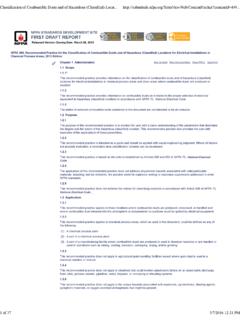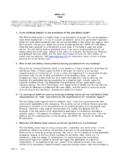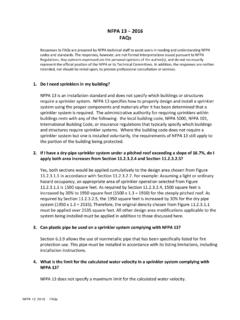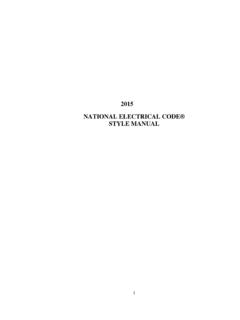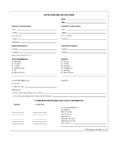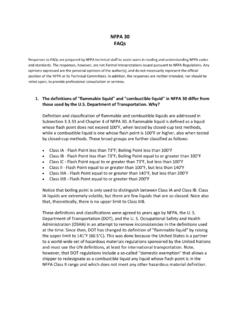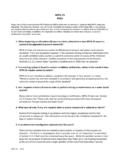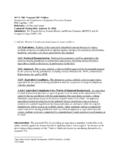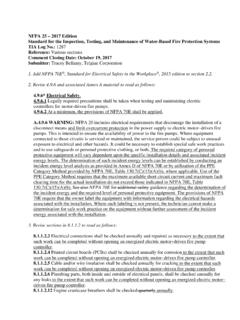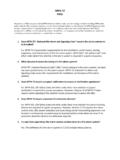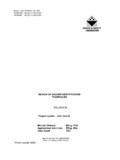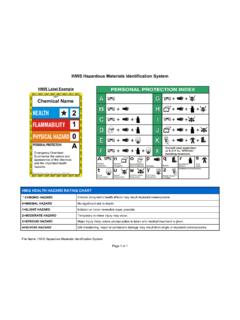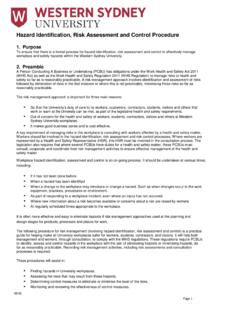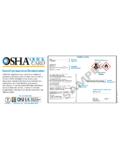Transcription of System for the Identification of the Hazards of Materials ...
1 Frequently Asked Questions on NFPA 704 Standard System for the Identification of the Hazards of Materials for emergency response 1. What is NFPA 704? NFPA 704 provides a simple, readily recognized, easily understood System for identifying the specific Hazards of a material and the severity of the hazard that would occur during an emergency response . The System addresses the health, flammability, instability, and special Hazards presented from short term, acute exposures that could occur as a result of a fire, spill, or similar emergency . 2. How does the 704 label differ from other hazardous material labels? There are several widely used systems for labeling hazardous Materials . Each has a specific purpose and it is important to recognize the differences between each.
2 Table 1 provides a brief summary of the purpose and use of three common labeling systems used for hazardous Materials . Note that you may see more than one label on a container depending on the situation. (See Question 11 for additional information on the differences between OSHA HazCom 2012 classifications and NFPA 704 ratings) Label Type Purpose Typical Label Location Label Example NFPA 704 Diamond Provides information about Hazards that occur during emergency response Outside buildings, on doors, on tanks, visible to emergency responders during spill or fire DOT Placard Provides information about Hazards to transportation workers and emergency responders Tank cars, cargo tanks, portable tanks, bulk packages, vehicles or containers containing non bulk packages OSHA HazCom 2012 Provides information about Hazards to workers using chemicals under normal conditions of use Pipes, drums, and containers of Materials that are used in the workplace Table 1.
3 NFPA, DOT and OSHA Placard and Pictograms 3. When am I required to use the NFPA 704 rating System ? NFPA 704 labels are required when another Federal, state or local regulation or code requires their use. NFPA 704 does not specify when a container, tank or facility must label with the 704 diamond. It tells you HOW to label when another code, standard or an AHJ (Authority Having Jurisdiction, such as the local fire department) requires such labeling. Some of the more widely adopted and used NFPA codes that require 704 labels for specific occupancies, storage, and hazardous Materials , include: NFPA 1, Fire Code NFPA 30, Flammable and Combustible Liquids Code NFPA 45, Standard on Fire Protection for Laboratories Using Chemicals NFPA 55, Compressed Gases and Cryogenic Fluids Codes NFPA 400, Hazardous Materials Code In addition, some facilities choose to utilize the NFPA 704 placards regardless of actual requirements in order to provide additional information on the Hazards of the Materials on site.
4 4. Why should I use the NFPA 704 rating System ? NFPA 704 labels provide an appropriate signal or alert for the protection of emergency response personnel, assist in planning for effective fire and emergency control operations, including cleanup. It can also assist all designated personnel, engineers, plant, and safety personnel in taking inventory and evaluating the relative Hazards of Materials in their facility. 5. How is the rating displayed? The System is characterized by the "diamond" that is actually a "square on point" shape. It identifies the Hazards of a material and the degree of severity of the health, flammability, and instability Hazards . Hazard severity is indicated by a numerical rating that ranges from zero (0) indicating a minimal hazard, to four (4) indicating a severe hazard.
5 The Hazards are arranged spatially as follows: health at nine o'clock position, flammability at twelve o'clock position, and instability at three o'clock position. In addition to the spatial orientation that can be used to distinguish the Hazards , they are also color coded as follows: blue for health, red for flammability, and yellow for instability. The shades of red, blue and yellow are not regulated, but should be contrasting colors. The hazard ratings may have colored backgrounds with contrasting colored numerals or colored numerals with a white background. (See Section and Figure (a) of NFPA 704) The six o'clock position on the symbol represents special Hazards and has a white background.
6 The special Hazards in use include W, OX and SA. W, indicates unusual reactivity with water and is a caution about the use of water in either firefighting or spill control response . OX, indicates that the material is an oxidizer. SA, indicates that the material is a simple asphyxiant gas (nitrogen, helium, neon, argon, krypton or xenon.) (See through of NFPA 704) 5. What other symbols can go in the special Hazards quadrant of the "diamond"? The only authorized symbols are the W, OX, and SA symbols described above. The number of symbols is kept to a minimum for emergency visibility and simplicity reasons. Many people ask about placing additional symbols such as "corr" for corrosive or "acid" for acids, but these Hazards are already taken into account in the health rating that is located in the blue section of the symbol.
7 6. Who provides NFPA 704 ratings and can I find those ratings in the Standard? While the System is simple in application, the hazard evaluation should be performed by persons who are technically competent and experienced in the interpretation of the hazard criteria as set forth in Chapters 5 8 of the NFPA 704 standard. A qualified individual can determine the ratings for a material by comparing data from the manufacturer supplied safety data sheets (SDSs) to the criteria located in NFPA 704. Though it is not required, some SDSs include the NFPA 704 diamond symbol with ratings, and some SDS provide the NFPA 704 rating numbers within text of the SDS. (See Question 7) While the criteria are located in NFPA 704, the actual ratings for specific chemicals are not included in the document.
8 The NFPA Fire Protection Guide to Hazardous Materials includes two withdrawn NFPA documents that contain hazard property information based on previous editions of NFPA 704 and include NFPA ratings for numerous chemicals. This information can be used for guidance, however ultimately the user is responsible for rating Materials using the SDS and the criteria located in the latest edition of NFPA 704. 7. What information on the SDS do I use to rate my hazardous Materials ? The ratings can be determined by using the information found on a HazCom 2012 compliant Safety Data Sheet (SDS) and comparing it to the criteria provided in NFPA 704. The following sections of the SDSs should be reviewed when determining the ratings: Health Sections 2, 4, 8, 9, 11 Flammability Sections 2, 3, 9 Instability Sections 5, 7, 10 Special Hazards Sections 5, 9, 10, 11 Caution!
9 ! Do NOT use the hazard category numbers given in section 2 of HazCom 2012 compliant SDSs as hazard ratings to be placed on 704 labels! (See Question 11 for additional information). 8. Where should I post the NFPA 704 placards at my facility and how many placards should I use? It is important to note that the placard is meant to provide quick hazard information for emergency responders. It should be visible in case of an emergency where the responders are likely to enter. If there are numerous areas where the responders could enter the facility, there should be numerous placards. The placement and quantity should be decided using a facility s best judgment coupled with the advice from your Authority Having Jurisdiction.
10 At a minimum the placard should be posted on the two exterior walls of a facility or building, each access to a room or area, or each principal means of access to an exterior storage area. Section of NFPA 704 provides guidance on locations for posting. 9. What size placard is required for NFPA 70? The size of the placard is dependent on the distance at which the hazard ratings must be legible. Chapter 9 of NFPA 704 provides guidance on both the size of the hazard ratings relative to the size of the placard to be posted and the minimum size of ratings based on the distance at which the ratings are legible. 10. If I have many chemicals in a storage room or if I have mixtures of chemicals, what ratings should I use on the NFPA 704 placard?
